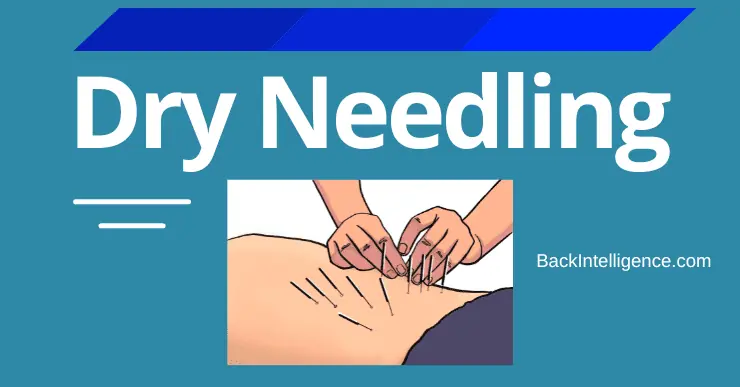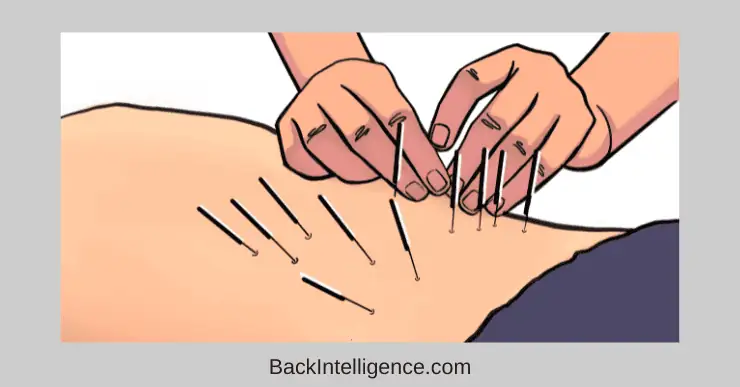
Dry needling involves sticking thin needles (filiform needles) into one’s muscle tissues in order to treat tight and painful muscle knots, aka trigger points. Muscle knots can develop from many things such as overuse of a muscle, trauma, poor posture, improper lifting technique and more.[1][2]
If left untreated these tight trigger points can also contribute to a decreased range of motion, muscle weakness and referred pain.[1][2]
There are several ways you can treat a trigger point including self massage and stretching, but when those things don’t help, or when you need a quicker intervention, dry needling may be worth a try.
At back Intelligence, we don’t recommend only doing dry needling. It’s a modality that is best saved as a last resort or for dealing with muscle pain that has been persistent for many months with no relief in sight. Also, It’s best used with other interventions, especially combined with self-massage.
How Does Dry Needling Work?
There are several dry needling techniques. The quick method is when the needle is inserted and then taken out after a few seconds. The longer, more advanced method involves inserting the needles and leaving them in for as long as 25 minutes. In both cases the practitioner may move the needle to help release the trigger points even more.[2][3]
The goal of inserting the needle into the muscle knot is to elicit a local twitch response, which in turn can release tightness in that spot. So when you feel a spot twitching/shaking, its suggesting that it’s working!
Additionally, your practitioner may connect the needles to an electrical stimulation device and you will feel an electrical pulse through the needle, which can further reduce the pain intensity, and acts as a way to numb the perception of pain one might feel.
Does it work? What does the research say:
Dry needling is an effective modality to explore. But its important to note that dry needling relief will only last when you are also fixing the underlying issues such as poor posture, muscle imbalances, etc.
Think of dry needling as treating the symptom, not the cause. It’s good at providing the necessary pain relief at the exact spot you need it, but that tightness/pain might have been caused by a completely different issue. The pain will most likely come back unless you fix the underlying cause.
There are several studies showing the efficacy of Dry needling.
- In this study, dry needling proved to be effective for treating neck and upper back dysfunctions.
- In this study, one dry needling session of an active trigger point in a rotator cuff muscle, reduced pain and intensity.
- This study showed that dry needling can reduce pain for chronic tension-type headaches.
I have done a few dry needling sessions in the Erector Spine muscle group and I can say from my own experience, it does work. However, the tightness can come back if you don’t fix the underlying issue, which in my case was tight hip flexors. This is why dry needling alone may not be enough.
What Areas Does Dry Needling Treat
- Thoracic upper back area[1]
- Neck pain[1]
- Shoulder pain[2][4]
- Tension-Type Headaches[3]
- Low back pain (Erector spine muscles)[6]
- Hip/Glutes
- And more
Acupuncture VS Dry Needling
While Acupuncture and Dry Needling may appear similar, these are 2 very different techniques.
Acupuncture comes from Chinese medicine which is based on placing the needles along meridian lines, through which qi (vital energy) flows. And so the needles are placed along these energy points, to open them up and restore the flow of energy, which in turn can (supposedly) alleviate pain.
Dry Needling is based on western medicine, where the needles are placed into specific trigger points – into the tissues of the muscle and fascia, in order to release these tight muscle knots. Dry Needling has proven to be more effective at relieving pain than acupuncture.[5]
Related:
Is Yoga Good For Back Pain? Research & Opinion
Ice or Heat For Back Pain? The Ultimate Guide
Self Massage Techniques – For 9 Body Parts
What is a chiropractic adjustment?
Sources:
[1] Lew J, Kim J, and Nair P. Comparison of dry needling and trigger point manual therapy in patients with neck and upper back myofascial pain syndrome: a systematic review and meta-analysis. J Man Manip Ther. 2021; 29(3): 136-146.
[2] Ziaeifar M, Arab AM, Mosallanezhad Z, et al. Dry needling versus trigger point compression of the upper trapezius: a randomized clinical trial with two-week and three-month follow up. J Man Manip Ther. 2019; 27(3): 152-161.
[3] Gildir S, Tuzun EH, and Eroglu G. A randomized trial of trigger point dry needling versus sham needling for chronic tension-type headache. Medicine (Baltimore). 2019;98(8): e14520.
Corrective Exercise Specialist (NASM-CES), Certified Personal Trainer (NASM-CPT), Professional Dancer
As a long time back sufferer Leon found unique methods to alleviate his pain using natural methods including self massage, exercise/stretching and postural habits. He founded Backintelligence.com to empower others to fix their postures and ease their back pain from home.

